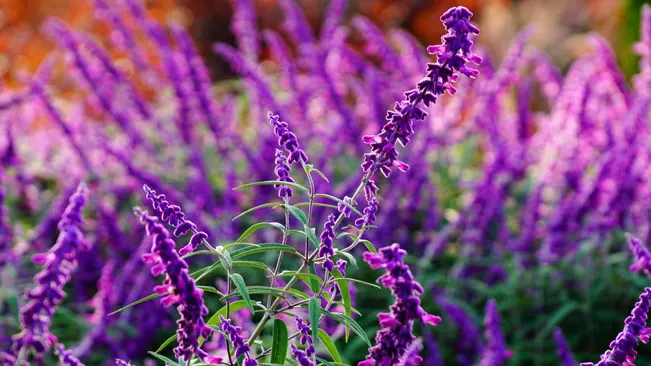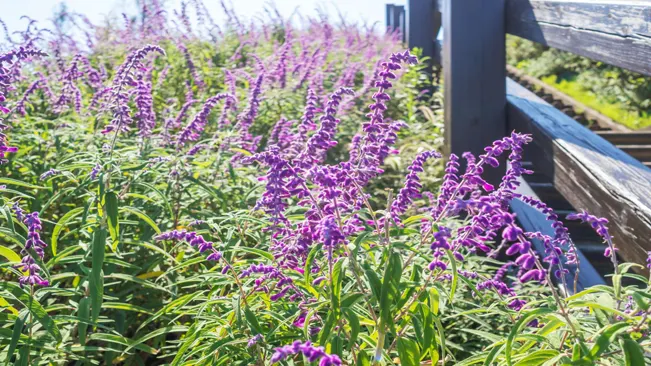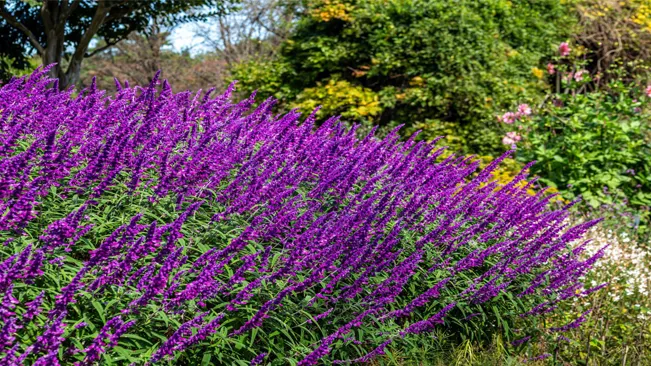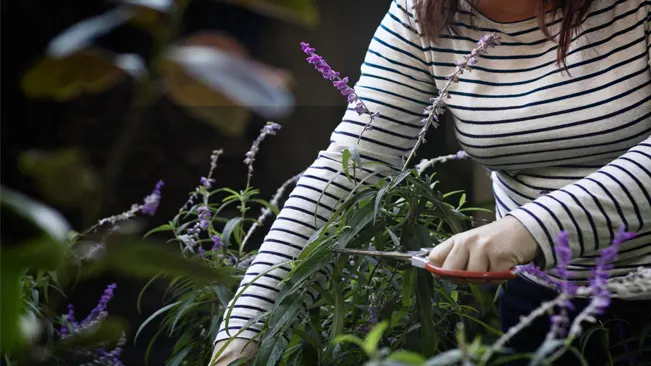Beginner’s Guide to Growing Mexican Bush Sage: Essential Tips
- March 6, 2024
- 0 comment
Mexican Bush Sage (Salvia leucantha), a vibrant and hardy perennial, is a favorite among gardeners for its stunning purple and white flowers and ability to attract pollinators. Originating from Mexico and Central America, this plant is well-suited for various garden settings. This article guides you through the essential steps to grow and care for Mexican Bush Sage successfully.

List How To Grow Mexican Bush Sage
- Choosing the Right Location
- Soil Preparation
- Planting
- Watering
- Fertilizing
- Pruning and Maintenance
- Winter Care
Choosing the Right Location
Maximizing Sun Exposure
Mexican Bush Sage (Salvia leucantha) is a plant that flourishes in environments with ample sunlight. This perennial requires a minimum of six hours of direct sunlight each day to thrive. The reason for this is twofold:

- Flowering Potential: Sunlight is a key factor in the plant’s ability to produce its beautiful, elongated purple and white flowers. In full sun, Mexican Bush Sage is more likely to bloom profusely and vibrantly. The intensity and duration of sunlight directly impact the plant’s photosynthesis process, leading to better growth and more abundant flowering.
- Plant Health: Adequate sun exposure also contributes to the overall health of the plant. It helps in maintaining a robust root system and strengthens the plant against diseases and pests. Sunlight aids in keeping the foliage dry and less prone to fungal diseases, which can be a problem in shadier, more humid environments.
Adaptability to Partial Shade
While Mexican Bush Sage is best suited to full sun, it is somewhat adaptable to partial shade conditions. However, there are trade-offs:
- Reduced Blooms: In partial shade, the plant may not produce as many flowers, and the blooms may not be as vibrant. The lack of sufficient sunlight can lead to fewer and smaller flowers.
- Leggy Growth: In an attempt to reach for more light, Mexican Bush Sage growing in less than ideal sunlight may develop a leggy, stretched appearance. This can impact the aesthetic appeal of the plant and may require more frequent pruning to maintain a desirable shape.
Considerations for Location Selection
When selecting a planting site for Mexican Bush Sage, consider the following:
- Sun Path: Observe the movement of the sun across your garden to identify spots that receive consistent sunlight.
- Seasonal Changes: Remember that the sun’s path can change with the seasons. A spot that’s sunny in summer may not be as sunny in spring or fall.
- Surrounding Vegetation: Be mindful of nearby trees or structures that might block sunlight, especially as trees leaf out in spring and summer.
Soil Preparation
This plant prefers well-draining soil. Amend heavy or clay soils with organic matter like compost to improve drainage. Mexican Bush Sage tolerates a range of soil types, including sandy and loamy soils, but avoid waterlogged conditions.
- Understanding Soil Types: This plant can grow in various soil types—sandy, loamy, or even clay. However, the key is to ensure good drainage. Sandy soils naturally offer excellent drainage but may require additional nutrients. Loamy soils are ideal, offering a balance of drainage and nutrient retention. Clay soils, while nutrient-rich, tend to retain water and may lead to root rot in Mexican Bush Sage.
- Amending Heavy or Clay Soils: If your garden has heavy or clay soil, it’s essential to amend it to improve drainage. You can do this by mixing in organic matter such as:
- Compost: A well-decomposed compost not only improves drainage but also adds essential nutrients to the soil.
- Aged Bark: Fine to medium-sized bark helps to create air pockets in the soil, enhancing drainage.
- Perlite or Vermiculite: These inorganic materials improve aeration and water drainage.
- Sand: Mixing in coarse sand can also help to loosen tight clay particles and improve soil structure.
- Maintaining Soil Fertility: While Mexican Bush Sage isn’t a heavy feeder, it still benefits from fertile soil. Organic matter like compost not only improves drainage but also slowly releases nutrients into the soil. A balanced, slow-release fertilizer applied in the spring can provide additional nutrients, especially in poorer soils.
- Checking Soil pH: This plant is adaptable to a range of soil pH levels but typically prefers slightly acidic to neutral soil (pH 6.0 to 7.0). If unsure about your soil’s pH, a simple test can be done using a home testing kit. Adjustments to soil pH can be made if needed, using soil additives like lime (to raise pH) or sulfur (to lower pH).
- Avoiding Waterlogged Conditions: Consistently wet or waterlogged soil can lead to root diseases and impact the plant’s health. Ensure that the planting area does not collect standing water, especially after rain. Raised beds or slopes can be beneficial for improving drainage in problem areas.
- Mulching: Applying a layer of organic mulch around the base of Mexican Bush Sage can help retain moisture in the soil, suppress weeds, and gradually improve soil quality as it decomposes. Be careful not to mound mulch directly against the stem, as this can cause rot.
Planting
Planting Time

- Planting in spring or early fall is ideal because these periods offer moderate temperatures which are conducive to root development. In spring, the soil warms up, encouraging root growth, and in fall, the cooler temperatures reduce the stress on the new plants. Avoid planting in the peak of summer or the dead of winter, as extreme temperatures can hinder plant establishment.
Spacing
- When planting Mexican Bush Sage, it’s important to give each plant enough room to reach its full size. This species can spread up to 3 feet in width, so spacing plants 24 to 36 inches apart allows sufficient room for growth. Proper spacing also ensures adequate air circulation, which is vital for preventing fungal diseases.
Planting Depth and Width
- Dig a hole that is twice as wide as the root ball of the plant. This allows the roots to spread out easily in the soil, which is essential for establishing a strong root system. The hole should be as deep as the container the plant came in. Planting at the correct depth is crucial; if planted too deeply, the plant could suffocate, and if too shallow, the roots might not establish properly.
Planting Process
- Inspect the root ball: Before planting, gently remove the plant from its container and inspect the root ball. If the roots are densely packed or circling, gently tease them apart to encourage them to grow outward into the surrounding soil.
- Positioning the plant: Place the plant in the center of the prepared hole. Ensure the base of the plant (where the stems emerge from the roots) is level with the surrounding soil surface. This positioning prevents water from pooling around the stem, which could cause rot.
- Backfilling the hole: Fill the hole with the removed soil, gently tamping down as you go to eliminate large air pockets. Air pockets can dry out roots and hinder growth.
- Watering: After planting, water the plant thoroughly to settle the soil around the roots and provide moisture essential for growth. Watering also helps eliminate any remaining air pockets.
- Mulching: Apply a layer of organic mulch around the base of the plant, leaving some space around the stem. Mulch helps retain soil moisture, suppresses weeds, and adds organic matter to the soil as it decomposes.
Watering
Water the plant deeply but infrequently. Mexican Bush Sage is drought-tolerant once established but benefits from regular watering during the first growing season. Reduce watering frequency as the plant matures, ensuring the soil is dry between waterings to prevent root rot.
Understanding Watering Needs
Mexican Bush Sage (Salvia leucantha) has moderate watering needs, especially during its establishment phase. The goal is to balance between providing enough moisture for healthy growth and avoiding overwatering, which can lead to root rot.
Initial Watering After Planting
- Right after planting, water the sage deeply. This initial watering helps settle the soil around the roots and removes air pockets.
- For the first few weeks, keep the soil consistently moist but not waterlogged. This supports the plant as it develops new roots in its new location.
Watering During the First Growing Season
- During the first growing season, regular watering is crucial. It helps the plant to establish a strong root system.
- Water once or twice a week, depending on the weather conditions. In hotter, drier climates, more frequent watering may be necessary.
Assessing Moisture Levels
- Before watering, check the soil moisture. The top inch of the soil should be dry to the touch. If it’s still moist, delay watering.
- Using a soil moisture meter can provide a more accurate assessment and prevent over or under-watering.
Established Plant Watering
- Once established (usually after a year), Mexican Bush Sage becomes more drought-tolerant.
- Reduce the frequency of watering. Allow the soil to dry out completely between waterings.
- During periods of extended dryness or extreme heat, occasional deep watering may still be necessary.
Techniques for Effective Watering
- When you water, do so deeply and slowly. This encourages roots to grow deeper into the soil, making the plant more drought-tolerant.
- Avoid shallow, frequent waterings, which lead to shallow root systems.
- Water at the base of the plant to keep foliage dry and reduce the risk of fungal diseases.
Adapting to Environmental Conditions
- Be mindful of rainfall and adjust your watering schedule accordingly. If there has been significant rain, you can skip the next scheduled watering.
- In areas with high humidity, less frequent watering might be necessary as the soil takes longer to dry out.
Seasonal Adjustments
- In the fall and winter, when the plant is dormant, reduce watering significantly.
- If you’re in a region where the plant dies back in the winter, you might only need to water occasionally, if at all, during these dormant months.
Fertilizing Mexican Bush
Feed Mexican Bush Sage with a balanced, slow-release fertilizer in early spring. Over-fertilizing can lead to excessive foliage growth at the expense of flowers.
- Type of Fertilizer: A balanced, slow-release fertilizer is ideal. This type of fertilizer releases nutrients gradually over time, providing a steady supply of essential nutrients to the plant. A balanced fertilizer typically has an equal ratio of nitrogen (N), phosphorous (P), and potassium (K), often labeled as 10-10-10 or 20-20-20.
- Timing of Application: The best time to fertilize Mexican Bush Sage is in early spring. This timing coincides with the beginning of its active growing season. Fertilizing at this time helps support new growth and flower production.
- Avoiding Over-Fertilization: Over-fertilizing can be detrimental. Excessive fertilizer, especially high in nitrogen, can lead to lush foliage growth but at the expense of flowers. Mexican Bush Sage is prized for its beautiful blooms, so it’s crucial to avoid anything that might inhibit flower production. Signs of over-fertilization include weak, leggy growth, fewer flowers, and possibly leaf burn or plant damage.
- Application Method: Follow the instructions on the fertilizer package for application rates and methods. Generally, the fertilizer should be applied around the base of the plant and then watered in well. Avoid getting fertilizer on the leaves or stems.
- Soil Considerations: The need for fertilization also depends on the quality of your soil. If your soil is already rich in organic matter, you might need to fertilize less frequently. In contrast, poorer soils might benefit from a bit more fertilizer.
- Additional Nutrients: In addition to balanced fertilizers, incorporating organic matter like compost into the soil can provide a range of nutrients and improve soil health and structure. Compost not only feeds the plant but also enhances the soil’s ability to retain moisture and nutrients.
Pruning and Maintenance

Pruning for Growth and Blooms
- Timing: The best time for pruning Mexican Bush Sage is in late winter or early spring. This timing is crucial because it prepares the plant for the new growth that occurs in spring and summer.
- Technique: When pruning, aim to cut back about a third of the plant’s size. Use clean, sharp pruning shears and make your cuts at a 45-degree angle just above a leaf node (the point on the stem where leaves are attached). This encourages the plant to branch out, leading to a bushier appearance and more stems that can produce flowers.
- Rejuvenation: In some cases, especially with older plants, more aggressive pruning may be needed to rejuvenate and invigorate the plant. This can involve cutting it back to just a few inches above the ground. Although this may seem drastic, Mexican Bush Sage typically responds well, producing vigorous new growth.
Deadheading for Continuous Blooming
- Process: Deadheading involves removing spent flowers. For Mexican Bush Sage, this means cutting off the flower spikes after the blooms have faded and before they start to form seeds.
- Benefits: This practice not only keeps the plant looking tidy but also encourages it to produce more blooms. By removing the old flowers, you prevent the plant from putting energy into seed production, which in turn stimulates it to produce more flowers.
Pest Management
- Common Pests: Aphids are a common pest that might affect Mexican Bush Sage. These small, sap-sucking insects can cause damage to the plant and also excrete a sticky substance known as honeydew, which can lead to sooty mold.
- Treatment: To treat aphids or other similar pests, you can use insecticidal soap or neem oil. These are effective, environmentally friendly options. Apply according to the product instructions, typically spraying directly onto the pests. It’s important to cover all surfaces of the plant, as pests often hide under leaves and in crevices.
- Prevention: Regularly inspecting your plants for early signs of pests and addressing infestations promptly can prevent more significant problems. Also, maintaining healthy plants through proper watering, fertilizing, and pruning practices can make your plants less susceptible to pest infestations.
Winter Care
Mexican Bush Sage is a perennial that is hardy in USDA zones 7 through 10. In these zones, it can survive winter outdoors. However, in zones lower than 7, it may not survive the freezing temperatures unless given special care.
Mulching for Protection
- Purpose of Mulching: Mulch acts as an insulator, protecting the roots of Mexican Bush Sage from extreme cold. It helps to maintain a more consistent soil temperature and also retains moisture.
- Choosing Mulch: Organic mulches like shredded bark, straw, or leaf mold are ideal. They not only protect the plant but also enrich the soil as they decompose.
- Applying Mulch: Apply a thick layer (about 2-4 inches) of mulch around the base of the plant, extending a few inches beyond the foliage. Be careful not to pile the mulch directly against the stems, as this can cause rot.
Dealing with Frost and Snow
In areas where frost or snow is expected, extra protection may be necessary.
- Frost Cloth: Covering the plants with a frost cloth can provide additional insulation. Ensure the cloth is lightweight and breathable to prevent moisture buildup.
- Snow Cover: If snow is expected, ensure the mulch layer is thick enough before the snowfall. Snow can actually act as an insulator, but it’s the freeze-thaw cycle that can be damaging.
Pruning and Care
- Pruning Before Winter: It’s not necessary to prune Mexican Bush Sage heavily before winter. The foliage can provide extra protection for the base of the plant.
- Spring Pruning: Once the danger of the last frost has passed and you start noticing new growth at the base, prune the dead parts. Cut back to just above the new growth.
Overwintering Indoors
For gardeners in zones colder than 7, consider overwintering the plant indoors.
- Dig Up Before Frost: Dig up the plant before the first frost and pot it in a suitable container with well-draining soil.
- Indoor Environment: Place it in a cool, bright room. Water sparingly throughout the winter, just enough to prevent the soil from completely drying out.
Conclusion
Growing Mexican Bush Sage is a rewarding experience for any gardener. Its low maintenance needs, coupled with its stunning blooms and ability to attract wildlife like hummingbirds and butterflies, make it a desirable addition to any garden. Follow these simple steps, and you’ll enjoy the vibrant beauty of Mexican Bush Sage in your outdoor space.
FAQs (Frequently Asked Questions)
- What is the best time to plant Mexican Bush Sage?
Plant Mexican Bush Sage in the spring or early fall to allow the plant to establish its root system before extreme temperatures, either hot or cold. - How much sun does Mexican Bush Sage need?
It thrives in full sun, requiring at least six hours of direct sunlight daily. It can tolerate partial shade but flowers best in full sun. - What type of soil is ideal for Mexican Bush Sage?
Well-draining soil is ideal. It can tolerate a range of soil types, including sandy and loamy, but avoid waterlogged conditions. - How often should I water Mexican Bush Sage?
Water deeply but infrequently. During the first growing season, regular watering helps establish the plant. Once established, reduce the frequency, allowing the soil to dry out between waterings. - Does Mexican Bush Sage need fertilization?
Fertilize with a balanced, slow-release fertilizer in early spring. Avoid over-fertilizing as it can lead to more foliage and fewer flowers. - How do I prune Mexican Bush Sage?
Prune in late winter or early spring, cutting back about a third of the plant to encourage bushy growth and more blooms. Deadhead spent flowers to promote continuous blooming. - Is Mexican Bush Sage drought-tolerant?
Yes, it is drought-tolerant once established, making it a great choice for water-efficient gardens. - Can Mexican Bush Sage survive winter?
In colder regions, it may die back in winter. Protect the roots with mulch and look for new growth in spring. - How far apart should I plant Mexican Bush Sage?
Space plants about 24 to 36 inches apart, as they can spread up to 3 feet. - Does Mexican Bush Sage attract wildlife?
Yes, it is known for attracting pollinators like bees, hummingbirds, and butterflies, making it an excellent choice for wildlife gardens.

Kristine Moore
Forestry AuthorI'm Kristine Moore, a seasoned garden landscaping professional with over 30 years of experience. My extensive career has been dedicated to transforming outdoor spaces into stunning, sustainable landscapes. With a deep understanding of horticulture, design principles, and environmental stewardship, I have become a respected figure in the field, known for creating harmonious, visually appealing, and eco-friendly gardens. My commitment to excellence and continuous learning in landscaping trends and techniques has solidified my reputation as an expert in garden design and implementation.













Leave your comment